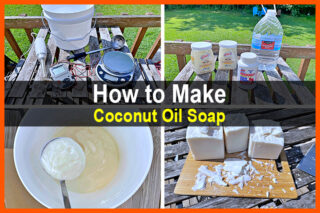
Over the past year, goats milk soap has become very popular. But why? What makes this kind of soap better than regular soap? People like goat milk soap because it's great if you have dry and/or sensitive skin. And if you have psoriasis or eczema, this soap will significantly improve your skin's health.
Goat milk contains alpha-hydroxy acids which can help you scrub away dead skin cells, leaving healthy new skin cells on the surface. Additionally, the cream in goat milk is a great moisturizer for dry skin. And on top of that, it contains vitamins and minerals such as Vitamin A and selenium.
Want to save this post for later? Click Here to Pin It on Pinterest!
So now that you understand the benefits of this type of soap, let's talk about how to make it. In this video, Brad and Krista Big Family Homestead explain their recipe for goat milk soap.
Safety tip 1: Make this soap outside or at least in a very well ventilated area as the fumes are very bad for you.
Safety tip 2: If you get lye on your skin, it will cause a chemical burn. Keep some white vinegar on hand as this will neutralize the burn.
Now on to the recipe…
Here are the ingredients:
- 3 cups of hot filtered water
- 17 oz of lye
- 2 lbs of coconut oil
- 2 lbs of soybean oil
- 2 lbs of canola oil
- 2 cups of lemon juice
- 1/3 cup of dry goat milk
- 2 oz of stearic acid
- 2 oz of liquid Vitamin E
- 1 oz of sweet almond oil
- 2 oz of essential oil
And here's how to make it:
- Put the hot water into a stainless steel pot and slowly add the lye. Stir gently until the lye dissolves. (Periodically check the temperature of the water and don't move on until it gets down to 150 degrees F.)
- Add the coconut oil, soybean oil, and canola oil. Continue to stir. Don't move on until the temperature gets down to about 115 degrees F.
- Start adding the lemon juice. Add it very slowly, stirring as you add it.
- Now add the dried goat milk. Gently whisk into the mixture.
- Add the stearic acid, liquid Vitamin E, and almond oil. Keep stirring until it's completely mixed.
- Make sure it's thick enough for trace (when you move a spoon across the surface of the mixture, it should leave a line behind). Then add the essential oil (in this case, peppermint oil), and finish mixing it up.
- Pour the mixture into your soap molds. You can use any type of plastic trays. Let it sit for 24 hours.
- Cut it into bars and let it dry for about three weeks before you use it.
Watch the video below if you want to follow along.










Someone needs to make corrections in the printed recipe above, it says “add the water to the lye.” that is NOT good. Watch the video.
You’re right, I typed it backward. Thanks for pointing that out! It’s fixed.
Why lemon juice? I just haven’t seen that used before.
Thanks